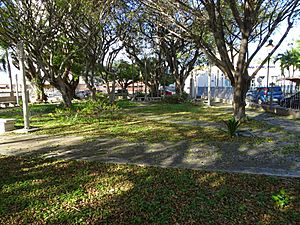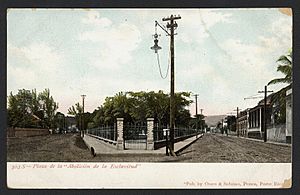Parque de la Abolición facts for kids
Quick facts for kids Parque de la Abolición |
|
|---|---|

Parque de la Abolicion in Ponce, Puerto Rico, looking west
|
|
| Type | Urban park |
| Location | Ponce, Puerto Rico |
| Created | 1874 (created)
|
| Operated by | Government of the Municipality of Ponce, Puerto Rico |
| Open | 9 a.m. to 5 p.m. Entrance free. Closed on legal holidays, except for scheduled events. |
The Parque de la Abolición (which means Abolition Park in English) is a special city park in Ponce, Puerto Rico. It's located in an area called Barrio Cuarto. This park is unique because it's the only one in the entire Caribbean region that remembers the end of slavery.
The park was first created in 1874. Later, it was updated and made even better in 1956. It's a place where people can learn about an important part of history.
Why This Park Exists
For many years, starting in the early 1500s, people were brought from Africa to Puerto Rico. They were forced to work as slaves. This happened because the native people who lived there before had become very few.
These enslaved people worked hard in different industries. They helped grow coffee and sugar cane. They also worked in gold mining. By the 1700s, gold mining wasn't as big, so most slaves worked on farms.
Slavery was officially ended in Puerto Rico on March 22, 1873. This was done by a special order from Spain, which ruled Puerto Rico at the time.
Park's Story and Changes
Just one year after slavery ended, in 1874, some local citizens decided to build a small park. They wanted it to be a lasting memory of this huge historical event.
In 1880, three important people helped make the idea of a park even bigger. They were Olimpio Otero Vergés, Juan Mayoral Barnés, and Román Baldorioty de Castro. They wanted a special park to honor the end of slavery.
Juan Mayoral Barnés presented the park idea to the Ponce city leaders on March 14, 1880. Everyone agreed, and the idea was approved by the government. It was even confirmed by a royal order on March 1, 1881.
The park was finally built and opened in the 1890s. It was a fun place for families! It had swing sets for kids and a fountain with colorful fish. Believe it or not, it even had a roller coaster!
Over 50 years later, on May 6, 1956, the park got a big makeover. The mayor of Ponce, Andrés Grillasca Salas, was in charge. The roller coaster, swings, and fish pond were removed. In their place, a new outdoor stage called the Concha Acústica was built.
A statue of a freed slave was also added to the park. It shows a black man with broken chains, symbolizing his freedom. This powerful statue was created by an artist named Victor Cott. The new Concha Acústica also opened in 1956.
What You'll Find at the Park
The park is located on Avenida Hostos. It's where Salud Street and Marina Street meet. Right behind the park is a tall, 100-foot monument. This monument is called the Monumento a la abolición de la esclavitud.
Across from the park, you can see the Darlington Building. This was Ponce's first building with many floors, finished in 1952.
The park has a nice green area with trees and stone benches. It also has two main monuments that remember the end of slavery in Puerto Rico.
One monument is the powerful sculpture of the freed slave. It shows a black man with broken chains, celebrating his freedom. The other is the very tall obelisk called the Monumento a la abolición de la esclavitud. It stands right behind the statue, making the message even stronger.
Between the green part of the park and these monuments is the outdoor amphitheater. This is the La Concha Acustica, which means "The Acoustic Shell." It's shaped like a shell to help sounds carry well. This amphitheater completes the park, which fills a triangular city block.
After being used for almost 70 years, the park was renovated in 1956. An architect from Ponce named Francisco Porrata Doria led this important renovation project.



